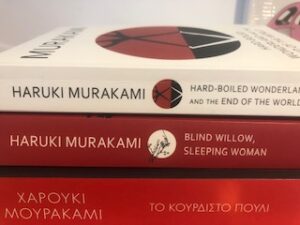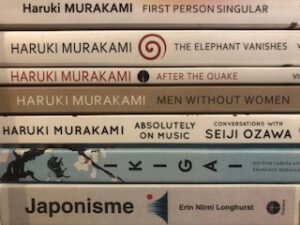12 Haruki Murakami books to read
Earlier this year, I published the post ‘23 Japanese books to read in 2023’. This was later followed by the post ‘9+1 Japanese literature classics’. Neither of these posts included any books by Haruki Murakami. The reason was that I was planning to publish another post specifically discussing some of his works (those I’ve read so far that is). Here it is.
Novels by Haruki Murakami
My fascination with Japan, which I am yet to visit, began in childhood. However, I was in my 30s when I first read a Japanese novel, Murakami’s Norwegian Wood. Since then, I have read many more Japanese novels. Through those, I have learned a lot about the country’s geography, history and modern culture. I have especially enjoyed those by Haruki Murakami. Referring to Murakami’s texts, Strecher’s words resonate with me:
“they entertain while at the same time giving life and body to historical events that might otherwise remain localized or obscure.”
So far, the critically-acclaimed Japanese author has published 15 novels, which have been translated in more than 50 languages. His first one, Hear the Wind Sing, was published in 1979, whereas his most recent one, The City and Its Uncertain Walls, was published in Japanese earlier this year, but it is yet to be translated into English (and therefore to be read by me). I have personally read 5 of his novels, some in Greek, some in English.

Some of his novels have been adapted into films, including Hear the Song of the Wind and Norwegian Wood.
Hard-Boiled Wonderland and the End of the World (1985)
This is Haruki Murakami ‘s fourth novel, as well as the last one I’ve read. It is also the earliest Murakami novel I’ve read so far. It was recently discussed in the Virtual Book Club: Japanese Literature, a book discussion club that meets online for an hour and a half each month. I would describe this novel as less surreal compared to the other ones I’ve read and more fantasy/science fiction (albeit with deeper psychological underpinnings). As I’m not a huge fan of science fiction, I did not enjoy it as much. It is a 400-page book, split between two parallel narratives, “Hard-Boiled Wonderland” (representing the outer mind) and “The End of the World” (representing the inner mind). There are a total of 40 chapters alternating between the two narratives.
Norwegian Wood (1987)
Norwegian Wood is one of Haruki Murakami’s most notable works and his first novel I’ve read. Named after the song ‘Norwegian Wood (This Bird Has Flown)’ by the Beatles, it is a realistic, coming-of-age novel dealing with several themes, including love and sex, as well as death and suicide. It is narrated by a man in his mid-30s, who reminisces his love affair with a troubled young woman, when they were both students at University. She had been the girlfriend of his best friend, who unexpectedly killed himself, while still at school. First published in Japanese in 1987, Norwegian Wood was translated and published in English in 1989. A film adaptation directed by Tran Anh Hung was released in 2010.
The Wind-Up Bird Chronicle (1994-5)
This 800-page novel was originally released in three parts. Like the Norwegian Wood and other Murakami works, it is narrated by a man in his mid-30s. The first part begins with the narrator’s cat gone missing. In the second part, the narrator’s wife also goes missing, but it turns out that she has left him. At the same time, the narrator meets an array of interesting characters, including a teenager neighbour, a medium and her sister (both named after Mediterranean islands), a mysterious well-dressed woman called Nutmeg and her mute son, Cinnamon, as well as an elderly man who used to be an officer in the Kwantung Army during the Japanese occupation of Manchukuo. I found The Wind-Up Bird Chronicle an interesting book due to the historical perspective that is successfully blended within the surreal plot.
Colorless Tsukuru Tazaki and His Years of Pilgrimage (2013)
This is another Haruki Murakami with a male protagonist in his mid-30s. However, unlike The Wind-Up Bird Chronicle and Killing Commendatore, this is a realistic novel. While the protagonist was studying at University away from his home town, his high school group of friends suddenly cut him off, no explanation given. This led him on the verge of depression and suicide. Years later, encouraged by the woman that he dates, he traces them down in search of an explanation. Not only he returns to Nagoya (their hometown), but he also flies to Finland, to achieve his goal.
Killing Commendatore (2017)
Killing Commendatore was first published in two volumes, The Idea Made Visible and The Shifting Metaphor. It shares a lot of similarities with other Murakami novels (it is narrated by a man in his mid-30s who has separated from his wife), and especially with The Wind-Up Bird Chronicle, in that they’re both surreal books with a historical perspective blended within the plot.
Short story collections by Haruki Murakami
Alongside his novels, Murakami has also written short stories. These have been published in a total of 5 books (in English), which I also discuss in this post.

Many of his short stories have been adapted into films, including Drive My Car, Burning and Blind Willow, Sleeping Woman. The latter was recently released and is actually an animated English-language film by Pierre Földes. It is based on six short stories by Haruki Murakami (from three of the collections mentioned below).
The Elephant Vanishes (1993)
The Elephant Vanishes is a collection of 17 short stories, first published in English in 1993. Murakami wrote the stories between 1980 and 1991, and first published them in various magazines. Among these stories, there’s Barn Burning, which was adapted into the South Korean film Burning, directed by Lee Chang-dong. It is a dark story about two men and a woman, who become entangled in a love triangle.
There’s also The Wind-up Bird and Tuesday’s Women, which was later updated as the first chapter of The Wind-Up Bird Chronicle.
After the Quake (2000)
After the Quake is a collection of six short stories, written in response to the 1995 Great Hanshin earthquake (commonly referred to as the Kobe earthquake). First published in Japan in 2000, it was released in English in 2002. Among these stories, there’s Super-Frog Saves Tokyo, one of the stories used in the film Blind Willow, Sleeping Woman.
Blind Willow, Sleeping Woman (2006)
This is a collection of 24 short stories, first published in English in 1993. Murakami wrote the stories between 1980 and 2005, and first published them in various magazines. Among these stories, there’s ‘Man Eating Cats’, which takes place on a Greek island, and Firefly, which was later reused within Norwegian Wood. Tony Takitani and Hanalei Bay have both been adapted into feature films.
Men Without Women (2014)
First published in 2014, this is a collection of seven short stories, translated and published in English in 2017. Among these stories, there’s Drive My Car, which was made into a film in 2021. Directed by Ryûsuke Hamaguchi, it won the Oscar for the Best International Feature Film at the 94th Academy Awards. Drive My Car is about a middle-aged actor and director, who, grieving the death of his wife, travels to Hiroshima to produce a new play for a theatre festival. There he meets a young woman, assigned to become his chauffeur, as well as his late wife’s lover.
First Person Singular (2020)
This is Haruki Murakami ‘s most recent collection of short stories. There are eight short stories in the book, which are all told in a first-person singular narrative.
Non-fiction books by Haruki Murakami
Murakami has also non-fiction books, two of which I discuss in this post.
Absolutely on Music: Conversations with Seiji Ozawa (2016)
Music plays a peripheral role in most of Murakami’s novels and in many of his stories. In fact, it is rather evident that he is a fan of classical music, jazz and the Beatles. It’s therefore not surprising that he published this book with his conversations with the Japanese conductor Seiji Ozawa. Absolutely on Music features six engaging conversations about classical music, which reveal the author’s love for classical music, as well as his encyclopaedic knowledge on the subject.
Novelist as a Vocation (2022)
This is the latest book by Haruki Murakami that I’ve read. Novelist as a Vocation is by no means a manual on how to write a novel, but more of an engaging reflection of the author’s experience and his thoughts and ideas about various topics related to his profession. It features 11 chapters (essays), where the he explores these thoughts and ideas. In doing so, he discusses his career and offers first-hand insight into his life and his works. For example, he talks about his ‘self-imposed exile’, explaining why he distanced himself from Japan’s literary establishment and relocated to the USA relatively early in his career. He then reveals that he started writing Norwegian Wood at cafes in various places in Greece, on board ferry boats and in the waiting lobbies of airports. He also discusses the importance of regular physical exercise in his daily routine.
To me, the lines separating the emotional, the mental, and the physical aren’t all that clearly defined.
Haruki Murakami
Further reading
The Forbidden Worlds of Haruki Murakami, by Matthew Carl Strecher
Matthew Carl Strecher is Professor of Modern Japanese Literature and an expert on Haruki Murakami. He has published 3 books about the latter’s works. Published in 2014, the Forbidden Worlds is his latest. In this book, Strecher discusses Murakami’s works from Hear the Song of the Wind to Colorless Tsukuru Tazaki and His Years of Pilgrimage, which he dissects and discusses in detail. I read the Forbidden Worlds recently, after I’d read all the other books discussed in this post. Although it is not an easy read (at the end of the day, the author is an academic), it helped me get a deeper understanding (and appreciation) of Murakami’s works. It specifically explores the surreal aspects of Murakami’s stories (referring to them as metaphysical or magical realism) and links those with Freud’s and Jung’s psychoanalytic theory.
Alex
(the Traveling Psychiatrist)